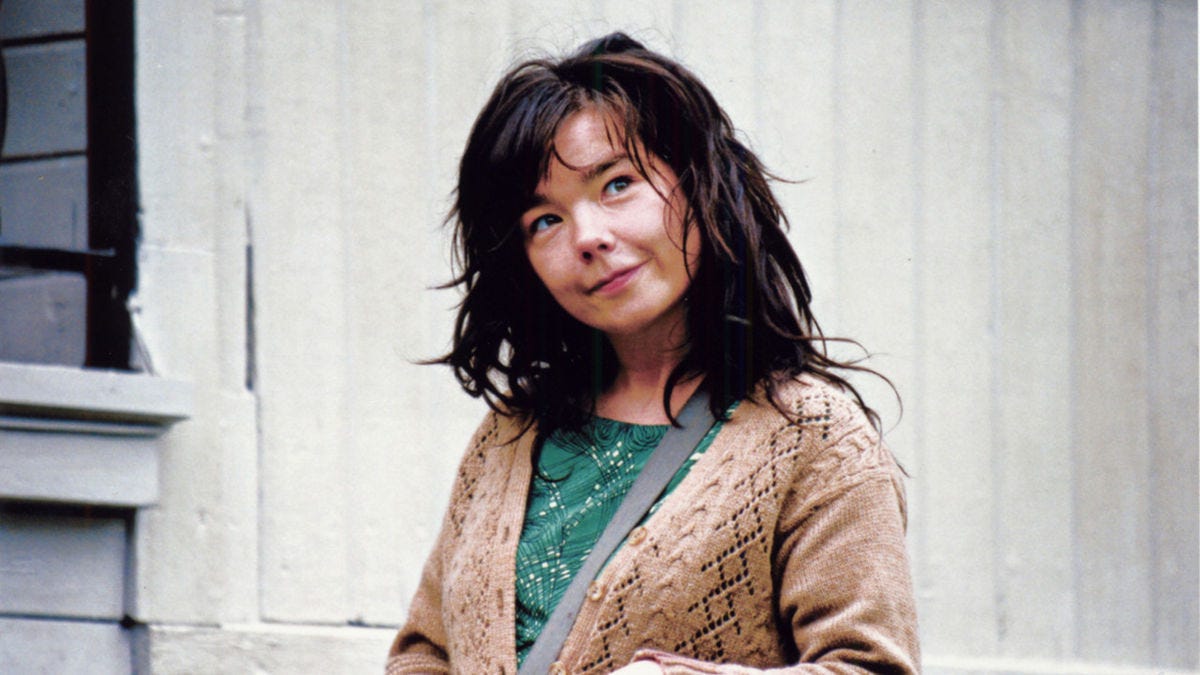Directed by Lars von Trier
Denmark and others, 2000
It’s oh so quiet … and then muted horns echo, gradually expanding and climbing to a triumphal timpani and brass fanfare before slipping back to the quiet. The screen fills with abstract visuals. This is an overture to an opera. We cut to a bespectacled Björk in rehearsal for an amateur theatrical production of The Sound of Music with of all people, Catherine Deneuve. What is going on?
Dancer in the Dark is a production by that purveyor of nihilist cinema Lars von Trier. It was the final film in his Golden Heart trilogy, preceded by Breaking the Waves and The Idiots, all three featuring tragic heroines. The trilogy was linked with Dogme 95, the avant garde movement whose aim was to strip cinema back to basics by eschewing usual filmmaking conventions. So using only hand-held cameras, diegetic sound, filming only on location, and a number of other restrictions. Von Trier does use hand-held cameras for the dramatic sequences here but largely abandons the rest of his manifesto, most notably by filming a musical with Björk, who both stars and writes the soundtrack (released as Selmasongs).
The film is set in the northwestern United States, where Selma Jezkova (Björk), is a factory worker obsessed with America musicals. Her backstory: she is a Czechoslovakian immigrant with a degenerative eye condition that will eventually lead to blindness. She has a son, Gene, who has the same condition and Selma is saving all of her money to pay for a curative operation for him. She works extra factory shifts and pins hairpins to cardboard to make extra money, keeping the whole enterprise a secret from everyone, including Gene. The only person she confides in is her best friend Cathy (Catherine Deneuve). So all the elements of a tragedy are in place.
Selma’s landlord, Bill (David Morse), is a local police officer who is in serious financial trouble and when she confides in him that she is going blind and has amassed enough money to pay for her son’s operation he steals all of her savings. Selma confronts him and in the ensuing struggle she shoots and kills him. The plot is as contrived or ridiculous as you would find in any opera and the dénouement is fairly predictable if you are familiar with the genre.
Björk is great: the sincerity and naturalism of her performance overcomes her limited acting ability and prevents the film from dissolving in a pool of acid cynicism. In contrast the French actor Catherine Deneuve looks perpetually bewildered, as if unsure she is in the right film. Perhaps she had expected something more like The Umbrellas of Cherbourg, the acclaimed innovative 1964 movie musical in which she played the lead. That might also explain the decision to cast her in a film set in the United States but shot in Sweden (von Trier has a fear of flying).
Björk’s vocal performance when the music starts – you have to wait until 40 minutes into the film – really does make your hair stand on end. The visual style of the musical numbers contrasts with the naturalistic narrative scenes: the camera becomes static but the palette blooms into Technicolor. The choreography is impressive but the editing is fragmented with repeated cutting away. It’s not clear what von Trier was trying to achieve here – was he undermining the musical aspects of the film deliberately, perhaps giving us an anti-musical?
Musicals not so much, but modern opera often takes a political stance and Dancer in the Dark could be read as a post-Cold War European critique of the promise of America and the West. Through the 1990s, after the fall of the Berlin Wall, the idea that liberal democracy was the final step in the evolution of civilisation was widespread.
This film preempts the bursting of that bubble with 9/11 and the subsequent financial crises. The rural industrial America depicted here is not so different from the Soviet Union and the factory has the atmosphere of a militaristic command economy. The later prison scenes allude to a political show trial: the bleak, white, labyrinthine corridors and the faceless bureaucracy leading to the theatrical courtroom.
Capitalism is rendered here in its most brutal form: fixing thousands of pins in order to pay for an operation – a nod to Adam Smith’s Wealth of Nations?
“Bill loves to talk about money, make sure you mention that money” – Selma
And then, the All-American, home-owning, police officer – that model of law, society and the American dream – is ultimately forced to rob an impoverished blind woman who has fled from a Warsaw Pact country.
We debated whether Lars von Trier was, with Dancer in the Dark, making a work of serious intent. You could read some elements of the film as contemptuously provocative and emotionally manipulative. The plotting is simplistic and melodramatic. The characters lack subtlety and are black and white in their motivations and actions. What we are watching is a modern day version of a silent film from the early days of Hollywood.
This isn't the last song, there's no violin, the choir is quiet, and no one takes a spin, this is the next to last song, and that's all...
Reids’ Results (out of 100)
C - 73
T - 72
N - 72
S - 71
Thank you for reading Reids on Film. If you enjoyed it please share with a friend and do leave a comment.




